http://www.osengines.com/motors/index.html By Ken Myers April 2012 Forward I purchased two O.S. Motor OMA-3820-1200 brushless outrunner motors for a sport twin project. Last fall I purchased the O.S. Motor OMA-3825-750 for a "club trainer" ARF. I found the fit and finish of the outrunner motors to be very nice on all three. I do not take my motors apart when testing them, so I have no comments about the actual construction. The OMA-3825-750 performed well through the remainder of the 2011 flying season and continues to perform well this year using a 4S1P "A123" 2300mAh battery pack and an APC 12x8E prop. The twin, about 725 sq.in. and about six pounds, uses a 3S2P "A123" 4600mAh pack. That is two 3S "A123" 2300mAh packs in parallel. I have a lot of experience with 3S "A123" 2300mAh power systems. I use a Hyperion HP-Z3019-10 (3744-1220, 160g) in my Son of Swallow, a Scorpion S-3020-11 (3838-1230, 154g) in the Fusion 380 and a Scorpion SII-3014-1220 (3840-1220, 129g) in a parkzone T-28. All three 3S "A123" 2300mAh systems use a Master Airscrew 10x8 G/F Series 3 prop and initially draw about 35 amps at 8.6 volts for about 300 watts in. The OMA-3820-1200, whose generic name (can diameter mm, can length mm dash Kv, wt. in grams) is, according to O.S. Engines/Motors, a 3843-1200, 155g. It looked like a good choice for the twin. The Kv, as will be demonstrated, is closer to 1245. A list of similar motors that I own: Hyperion HP-Z3019-10 (3744-1220, 160g)
Using the generic naming demonstrates that these are quite similar motors by the outside dimensions of diameter and length, Kv and weight. The Scorpion SII-3014-1220 is a bit lighter but still "in the ballpark." Part of the reason for my purchase of several of the Scorpion motors has been my perceived value. I have two more Scorpion S-4035-250s waiting for homes in two large biplanes and a Scorpion SII-3026-710 in my Super Stearman. The quality of the motors appears to be very good and the service and information provided on the Innov8tive Designs Web site is top notch! Great job Lucien Miller! The product, service and information are all part of my perceived value. Unfortunately, the Scorpion line of outrunners has passed my perceived value price point due to substantial price increases. That is why I purchased my first O.S. OMA-3825-750. It was less expensive than the equivalent motor from Innov8tive Designs for either the Scorpion or Cobra lines. While the information provided by O.S., and therefore Tower Hobbies, proved to be inaccurate for all three motors, I have never found a problem with service from Tower Hobbies. When I took the price and service into consideration, the O.S. brand seemed to be an okay value. I am a member of the Tower Hobbies Super Saver club. Members of the Tower Hobbies Super Saver Club are often offered free standard shipping with a minimum purchase of $99 and with the purchase of $100 or more about a 15% discount when using a certain Ad Number Code. If purchased with other items, it is possible to get the motor for about $59.50 delivered. Therefore, I got these two motors for about $119, which is a perceived good value to me. O.S. Engines spreads the information and specifications across three pages on its Web site. The homepage (http://www.osengines.com/motors/index.html) shows only four of their motors as of April 2012, although they have more according to the US distributor for them, Tower Hobbies. 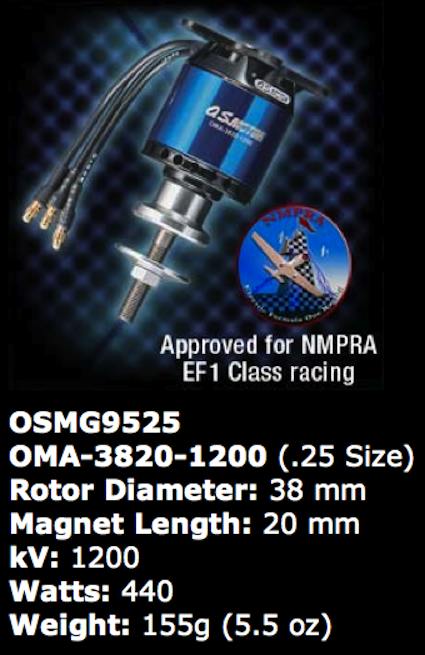 According to the information provided by the image capture from the O.S. Motor homepage, it is supposed to be a .25-size motor when relating it to a glow motor size. It is rated to a maximum of 440 watts in and weighs 155g/5.47 oz. 440 watts in / 11.1v (11.1v, as used here, is the loaded voltage fairly near the beginning of a 3S Li-Poly battery discharge, but after the initial run down at the beginning of the pack. The way that I am using the 11.1v is not in reference to the "nominal" cell voltage multiplied by 3) = 39.6 amps
Typical use for fly-on-the-wing type aircraft would be between 235 watts in and 425 watts in for this motor weight. On the other hand, simply as an illustration, it is the amps passing through the stator wires that is one of the wattage limiting factors. 40 amps * 14.8v = 592 watts in. 592 watts in / 155g of motor weight = 3.82 watts in per gram of motor weight. An important piece of information about this outrunner motor is that it is "Approved for NMPRA EF1 Class racing".
Because it is a 'racing' motor, the motor is designed to turn a relatively small diameter, high pitched prop at high RPM. It also means that the motor, like the rest of the equipment making up a racing plane, is expendable to the racer. According to the EF1 New Rules, the battery is to be a 4-cell Lithium Polymer weighing not more than 325g with wire and connectors and ONLY an unmodified, except for balancing, APC 8x8E thin electric prop is to be used. As evidenced later in this review, an APC 8x8E, with a GOOD 4S Li-Poly, statically pulls about 58 amps for about 865 watts in. That is just a little less than twice the O.S. maximum recommended wattage for this motor. With an RPM of about 14,900 the static pitch speed is 112 mph. At 58 amps the drive efficiency is still about 75% providing about 670 watts out or about 0.9 shaft horse power (shp). That equates to 865 watts in / 155g motor weight = 5.58 watts in per gram of motor weight. Typically 3 watts in per gram of motor weight is considered the high end for typical fly-on-the-wing flying and 3.5 watts in per gram of motor weight to 4 watts in per gram of motor weight the high end for burst type flying such as 3-D aerobatics or the fast climbing soaring types. The online specification sheet (http://www.osengines.com/motors/specifications.pdf) and the instruction sheet provided with the motor are interesting in that NO data is given for the APC 8x8E. 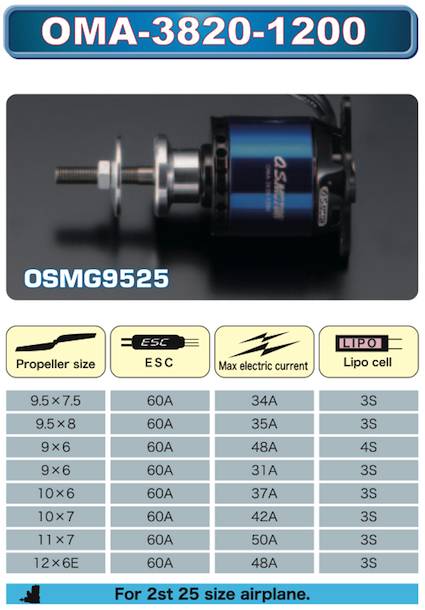 The online information is very limited. The propeller information provided on the instruction sheet packed with the motor is duplicated below. |
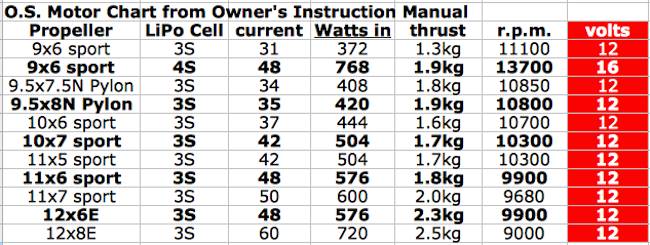
|
The instruction sheet states, "Propeller data are just examples. Used propellers are APC. E in the size stands for designed for electric motor. Others are designed for engines. Shown data are just for reference. Data may vary according to various conditions. Be sure to measure the current value with a measuring instrument. Be sure to use the motor within the acceptable range of the speed controller (ESC) and Li-Po batteries." The data was changed in the table presented in the instructions by renaming the propellers to APC standards and adding a volts column using the stated watts in divided by the stated current. The numbers in the volts column were NOT rounded! There is no explanation as to why they are 12v and 16v. To demonstrate how "inaccurate" and unhelpful the provided data is, an APC 10x6 sport prop at 12v pulls about 50 amps, not the 37 amps as indicated in the table. Even with a more realistic "real world" 3S voltage under load of 11.1v, the amp draw is expected to be about 45 amps. This data comes from Drive Calculator (http://www.drivecalc.de) and is discussed later. Tower Hobbies is THE USA importer (under the Great Planes name) and distributor for O.S. Engines. The Tower Hobbies nomenclature is O.S. .25 Brushless Motor ($69.98US as of April 2012)
The Tower Hobbies' product page basically reiterates the information on the O.S. Engine Web site. The dimension information is found at http://www.osengines.com/motors/dimensions.pdf. |


|
The table shows the O.S. dimensions and measured dimensions for the two motors in hand. It is unclear as to why ALL of the O.S. Motors list 11.5mm as the shaft length. |

|
The table shows the measured weights using a scientific triple-beam balance scale. * Three 3.5mm female bullet connectors and three pieces of heat shrink tubing are also provided for the ESC and weigh 2.3g/0.08 oz. for all three connectors and three pieces heat shrink tubing. From the dimensions and weights a generic name may be derived for the outrunner motor. Generic Name: (can diameter mm, can length mm dash Kv, wt. 3843-1200, 157g) Once the actual Kv is determined, the generic name -Kv may need to be corrected. The weight has already been corrected by 2g as shown in the Weights table. Poles: 14
Drive Calculator is a FREE power system analysis computer program that runs on Windows, Mac and Linux operating systems. It provides reasonable estimations of power system expectations and performance for propped aircraft. Accurate data entry is essential. Volts, amps and, very importantly, RPM are required for two no load data input points as well as four loaded data input points to model the motor. The Hyperion Emeter II was used to gather all of the data. Four propellers were balanced for use during the testing; Graupner 8x6 Nylon, APC 9x7.5E, Master Airscrew 10x8 G/F 3 Series and APC 11x7E. First the Kv (rpm/V) was determined using the drill press method for both motors.
Motor #1 measured weight/no prop adapter: 157.5/5.56 oz.
Motor #2 measured weight/no prop adapter: 157.05/5.54 oz.
A new Castle Creations' Thunderbird 54 ESC was prepared by soldering on the 3.5mm female bullet connectors for the motor connection and Anderson Power Poles (APP) connectors for the battery connection. Castle Creations Thunderbird 54 ESC (default timing as timing cannot be changed)
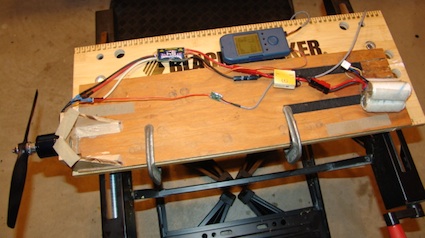 For the first motor, a fully charged 3S "A123" 2300mAh pack was used, without recharging, for all of the data gathering, except for the one no load test that was done with a 2S "A123" 2300 pack to obtain the no load data at a different voltage. The same procedure was used for the second motor. Four data points were gathered and averaged for the no load inputs into Drive Calculator.
A spreadsheet showing the gathered data is available at www.theampeer.org/OMA-3820-1200/OS-25-outrunner.xls. The only significant difference from the O.S. specifications was the Kv. The drill press method yielded (#1 - 1242 & #2 - 1249) and Drive Calculator's computations showed (#1 - 1247 & #2 - 1250) in the motor window for each motor respectively. That averaged out to a Kv of 1247. A composite motor was created using the data gathered from the two motors. It is found on the spreadsheet in the tab titled "composite motor". The drill press composite Kv is 1245.6 and, once the data was entered in Drive Calculator, the Kv on the motor page was 1245.9. I am satisfied to call the Kv 1245. My generic name for this motor is now the O.S. 3843-1245, 157g. The spreadsheet also calculates the propeller factor and exponent used by Drive Calculator. Two motors were created in Drive Calculator with the collected data and the Drive Calculator results compared to the "real world testing." Once the simulated motors were evaluated for accuracy, a table was created for possible propeller use. Because of its design, with the weight limiting the acceptable power level and the relatively high Kv, it is not a good choice for use with 4S Li-Poly batteries for sport flying. The amp draw is too high and the prop diameter too limited. Therefore there are no 4S applications suggested in the Prop Chart. The following numbers were used to create the chart:
The 11.7 volts under load is usually seen on a power meter somewhere near the beginning discharge of a freshly charged 3S1P Li-Poly battery. It will most likely appear within the first 15 seconds after reaching full power during a static run. The 11.1 volts gives a better indication as to the props to consider. When looking at the prop tables concentrate mostly on the 11.1v row or 7.4v row of the 2S table. Of course Drive Calculator allows the user to "play" with various capacity packs and props. The tables give an indication as to which props might be appropriate. Of course the props have to be matched to the appropriate airframe and type of flying. |
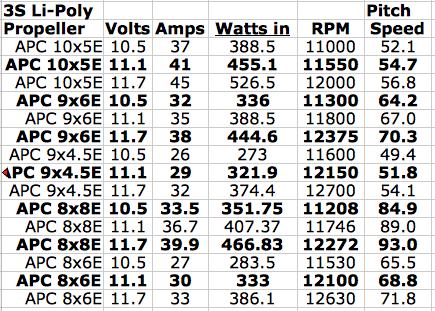

|
2S Li-Poly of appropriate capacity - This is not really a good choice as a lighter motor could easily do the same "work". Also, to use this motor with only a 2S requires "amping" it up to the maximum amp draw to attain at least 232.5 watts in. That is not really a good idea.
The prop chart from the O.S. Motor Instruction Sheet was presented earlier and implies that they are suggesting a prop range of from an APC 9x6 sport through an APC 12x8E. In the Motor Specification and Dimension Charts on the same instruction sheet they state that the rated current is 30~40 amps and maximum current is 75 amps. |
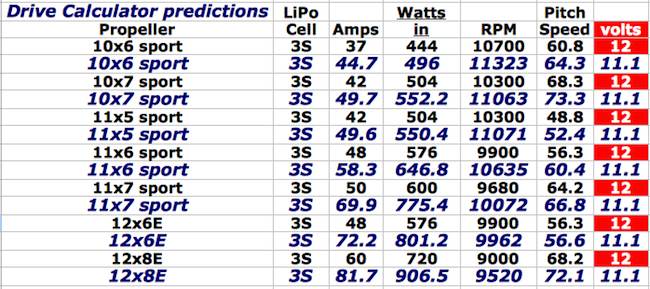
|
The table shows the O.S. Numbers in bold, black and the Drive Calculator predictions in bold, italic, blue. The APC 9x6 sport, 9.5x7.5N and 9.5x8N are not shown in the table as Drive Calculator does not contain prop constants for those props. |

|
The table of MY suggested props for a 3S Li-Poly battery is reproduced again for direct comparison. The props listed in MY suggested props table are all "smaller" than the recommended O.S. props. Drive Calculator data is only useful if it actually comes relatively close with its predictions to "real world" measured data! Since I do not own any Li-Poly packs, I used "real world data" from RC Groups to verify that Drive Calculator's predictions are "in the ballpark". /www.rcgroups.com/forums/showpost.php?p=21316517&postcount=216 provides "real world data" using an APC 9x6E prop and five different 4S Li-Poly packs. The author even provided photos of his power meter readings and ICE ESC logs in this post, www.rcgroups.com/forums/showpost.php?p=21314231&postcount=208. From Post #216
Using the Wattmeter 847.8W / 56.93A the voltage is 14.892v 14.892 was entered into V (voltage) box in DC for the composite motor that has been uploaded to the DC database. The screen capture shows the results. Note that the name of the prop is the 9x6 APC E alt KM. This prop may not have been uploaded to the Drive Calculator database. Here are its numbers for Drive Calculator.
|
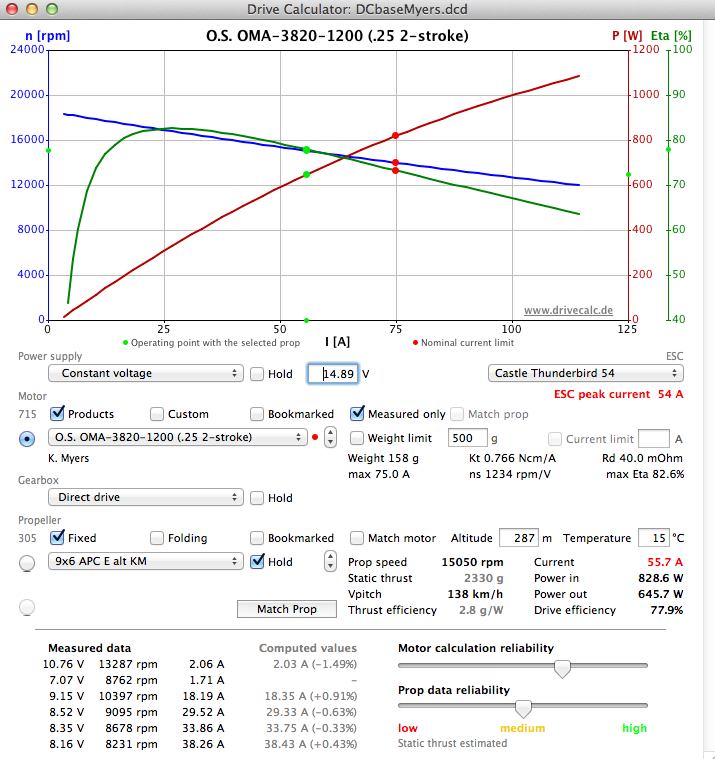
|
Again, from Post #216
The original poster did not capture the data for test 4 from his power meter. The calculated volts, used in the Drive Calculator computations, are in italics. Test #1 w/ Hyperion 4S 2100mAh 25C
Test #2 w/ Hyperion 4S 2200mAh 35C
Test #3 w/ Hyperion 4S 2600mAh 35C
Test #4 w/ Turnigy Nano-Tech 4S 2650mAh 35C
Test #5 w/Turnigy Nano-Tech 4S 2250mAh 65C
It appears that the motor has been "modeled" well in the Drive Calculator program. Note: The above numbers are from the composite motor, based on both of the motors I have test, that I've uploaded to Drive Calculator. My #2 motor has even closer predictions to the poster's posted data. www.rcgroups.com/forums/showpost.php?p=21334691&postcount=233 provides more information verifying the Drive Calculator modeling using an APC 8x6E prop. 4S Turnigy 2200 4 seconds into run 49.2A, 750W IN, 15702rpm 15.244v
4S Nanotech 35/70 2650 5 seconds in 48.9A, 750W IN, 15822rpm 15.337v
Note: I did not use Drive Calculator's default APC 8x6E for the above. I have my own, measured prop factors for an APC 8x6E; Factor 0.111 & Exponent 3.1, Altitude 224m, Temperature [C] 18.0. Also, I did not take the elevation into account in either posters' data. www.rcgroups.com/forums/showpost.php?p=21351165&postcount=252 provides more information verifying the Drive Calculator modeling using an APC 9x6E prop. The poster, Alpha_Geist, is the same poster for posts 216 and 208 whose data was previously used. 1st flight:
The posted data is from the data log of an Ice ESC. The initial voltage 16.5V and MAX RPM of 15597 are not useful for verifying Drive Calculator data. All of the data must be gathered at the same moment in time. The screen capture below shows the data when the amps are 55.4 and watts in are 809. The voltage for Drive Calculator was calculated by dividing the 809 watts in by the 55.4 amps. The Graphed RPM is 14,968.9. |
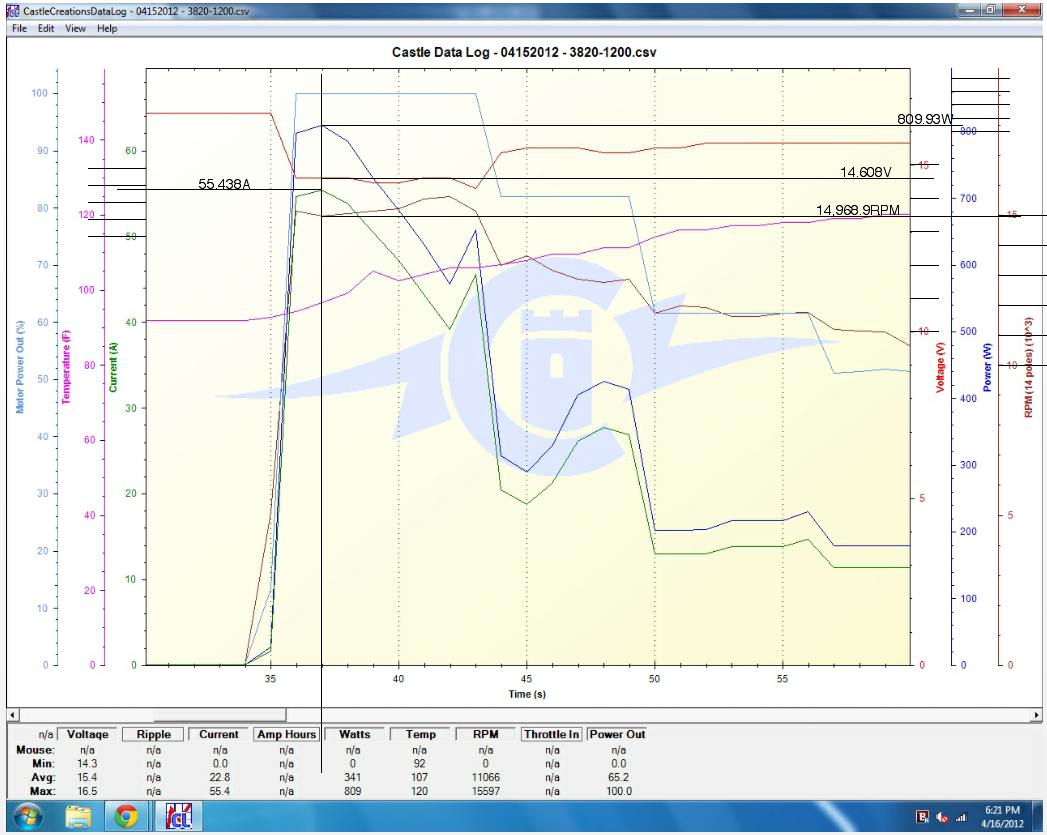
|
2nd flight:
3rd flight:
Also included in post 252 was data for a new prop on this motor, the APC 8x8E using a 4S Li-Poly. Initial Voltage: 16.4V, MAX Current: 54.6A, MAX Watts In: 781W, MAX RPM: 14731 rpm voltage used in Drive Calculator: 781/54.6 = 14.304v Graphed RPM 14,119
The Drive Calculator calculations were computed using the 8x8 APC E alt km prop.
It appears that the prop data provided by O.S. is incorrect, and that it is not even a good suggestion to consider it. Even though they state that, "Propeller data are just examples.", they are pretty much useless examples. From all outside appearances the O.S. Motors' outrunners seem to be decently produced. The examples that I tested run smoothly both with and without a prop load. My perceived value is fair because O.S. Engines and Tower Hobbies stand behind them. The biggest drawback is that the end user needs to gather the important motor parameters to select the appropriate propellers that will not "overload" the motor. The recommended propellers are just "wrong" for keeping the motor within the stated amp limits for sport flying! Racers and those that just want to go fast at any cost. like the poster on RC Groups, can follow the O.S. Motor propeller recommendations, including using an APC 8x8E on a 4S Li-Poly pack for racing. They should be aware that the motor life may not be great and that an ESC higher than the recommended 60 amps, as implied on the specification page (www.osengines.com/motors/specifications.pdf), may also be necessary. The prop adapter is not long enough from the backplate to the end of the threaded shaft to allow use of a typical spinner. The distance from the backplate to the front, first thread is approximately 1". The prop nut is about 0.2" thick and prop washer about 0.12" thick. Spinner backplates are typically about 0.25" thick. That limits the prop hub thickness to 0.43". A Master Airscrew 10x8 G/F 3 Series prop has a hub thickness of 0.49". Oops! This is NOT just an O.S. problem, as most of the motor suppliers of this size outrunner supply a prop adapter that is too short to fit many spinner types. Luckily, I had used the online dimensions and calculated that the "stock" prop adapter might not work with the spinner I want to use. I ordered a pair of Hyperion Extra Long 5mm Adapters to replace the stock O.S. adapters, if I found it necessary. A 30mm/1.1875" distance from the backplate to the first thread would be nice! I am looking forward to completing my twin and putting these two motors to work. Remember that the generic name helps in identifying similar outrunner motors. The generic name consists of the first two digits diameter in mm then second two digits length in mm then dash Kv comma weight in grams. O.S. Motor OMA-3820-1200 (3843-1200, 155g) Rated current per instruction sheet 30~40 Maximum current 75
AXI 2820/10 GOLD LINE (3548-1200, 151g) Current capacity 42 A/60 s
Scorpion SII-3014-1220 (3840-1220, 129g) Max Continuous Current 46 Amps
Cobra C-3510-16 (4336-1200, 141g) Max Continuous Current 42 Amps
There is no maximum or current capacity versus time given for the Scorpion or Cobra motors, but the 75 amps of the O.S. Motor exceeds the AXI current capacity. The O.S.'s 40 amps seems quite typical for this size outrunner. Similar, but "cheaper", outrunner motors for those that want to go "fast" with a small diameter prop or use 3S "A123" 2300mAh packs in a sport manner and not pay the price of the O.S. are available. Exceed RC Rocket 3020-1250KV (3740-1250, 145g) max efficiency current (A) 20-36A, current capacity (A/s) 55A/60S
Turnigy Aerodrive SK3 – 3542-1250kv (3743-1250, 141g) Max Current (A) 54
NTM Prop Drive Series 35-42A 1250Kv (3544-1250, 148g) Max Current (A) 54
TURNIGY AerodriveXp SK-3542-1250kv (3543-1250, 135g) Max Current (A) 40
www.hobbyking.com/hobbyking/store/uh_viewItem.asp?idProduct=17920
Turnigy D3542/5 1250KV (3542-1250, 130g) Max Current (A) 46
The prop chart on this Web site, www.coastalplanes.com/tools/propchart.htm, and the information in this article answers the question. |